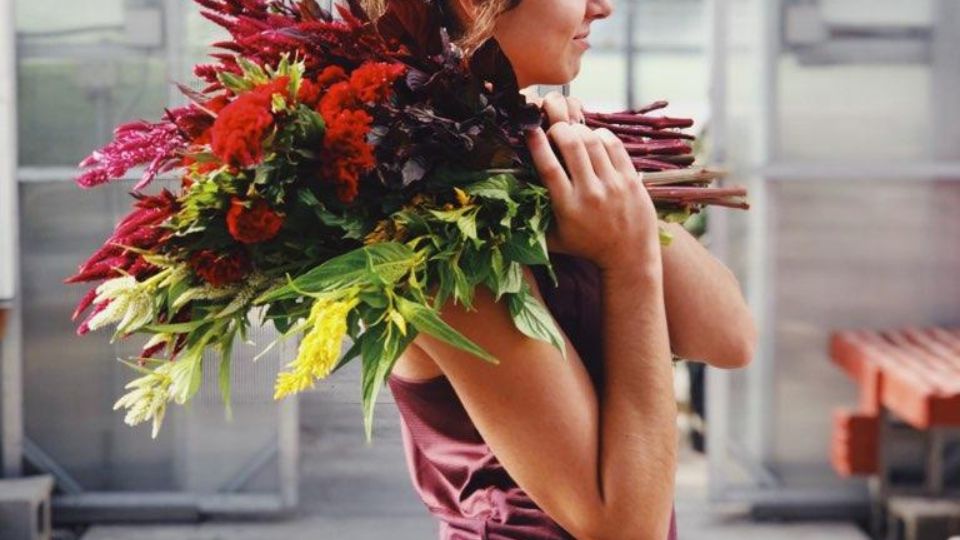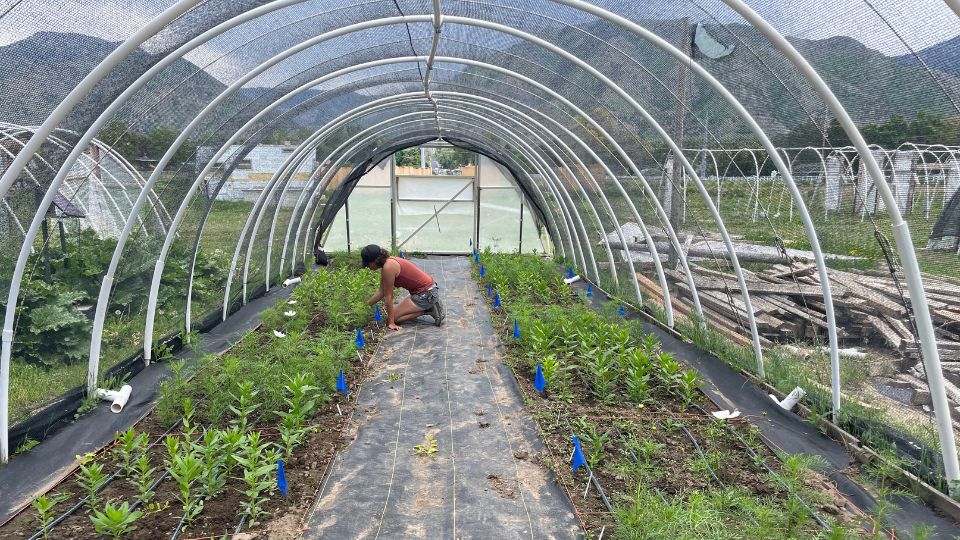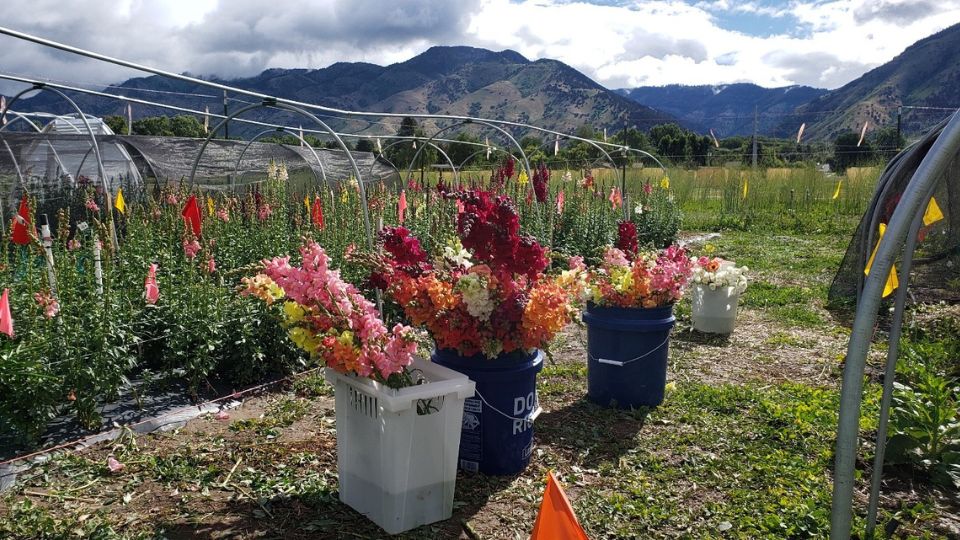Understanding Cut Flower Consumers

Overview
Flowers are most often purchased for personal use, with interior home decoration as the primary reason for cut flower sales in the United States (PR Newswire, 2022; Yue & Hall, 2010). However, gift use is also a significant reason for flower sales, with Americans spending over $100 billion on gifts, including floral offerings, each year (Rihn et al., 2011; Yue & Hall, 2010). Most of these floral gifts are given at calendar occasions such as holidays, particularly Valentine’s Day and Mother’s Day (Columbia & Stock, 2021; Yue & Hall, 2010). With two major gifting occasions in the first half of the year, demand is high early in the season, but additional holidays during the peak growing season also present opportunities for floral sales, including Memorial Day, Independence Day, and Labor Day (Columbia & Stock, 2021; Knoch, 2022).
Other non-calendar gifting occasions also significantly drive flower demand. These include birthdays, anniversaries, and unprompted expressions of love or appreciation (Yue & Hall, 2010). However, using cut flowers as gifts is viewed less favorably by younger generations (millennials and Gen Z) compared to older generations (baby boomers). Young adults often view flowers as a “risky gift” due to concerns about limited vase life (Rihn et al., 2014).
Large quantities of flowers are purchased for events throughout the year, such as weddings and funerals (PR Newswire, 2022). Couples spend $1,500 on average for their wedding flowers, which are used in bouquets, table centerpieces, backdrops, and other designs (Cain, 2022). Flowers used in events are often bred for higher quality and harvested to reach peak bloom on the day of the event (Cain, 2022).

Consumer preferences for flowers vary, with many preferring arrangements that reflect their personalities. Flower purchases are often based on aesthetic appeal, seasonality, and aesthetic and design trends, making decisions and preferences difficult to quantify (Rihn et al., 2011; Wang et al., 2016; Yue & Hall, 2010). However, flower color and fragrance are two of the most important characteristics of cut flowers at purchase (Irani et al., 2011). Additional factors influencing flower purchases include price, bloom and foliage quality, visual appeal, and availability or accessibility of floral offerings (Li et al., 2016). Additionally, early studies on consumer preferences found that form or the flower arrangement was a primary factor in influencing impulse purchases, with mixed arrangements of multiple flower varieties preferred over simple arrangements (Oppenheim, 1996). An online survey of flower consumers in Washington in 2012 found that the factors that impact purchases for personal use differed from those that impacted purchases for gift use, with quality and uniqueness valued more highly in gift purchases (Li et al., 2016).
UrbanStems, an online flower retailer, predicted that in 2023, bouquets with bold colors and environmentally friendly options would be popular (UrbanStems, 2023). The Florists’ Review suggests that upcoming trends represent both a return to tradition and innovation (Florists’ Review Media Group, 2023). Muted colors and whites are always popular due to weddings. Local flower growers, who often use direct-to-consumer sales, such as farmers markets and community-supported agriculture (CSA) subscriptions, have more freedom to grow and arrange flowers to suit their preferences or those of their customers (Anderson, 2021; Hays, 2022). These markets are less dependent on styles, trends, or strict standards set by retail florists and wholesalers, allowing for greater flexibility that may reduce waste and increase variety (Columbia & Stock, 2021).
Consumer Preferences: Demographics
Consumer demographics such as age, education level, and income all impact flower choice (Yue et al., 2010). For example, women aged 56 to 77 were identified as core consumers of fresh cut flowers, especially for personal use (Rihn et al., 2014). Another target market for cut flowers includes unmarried men aged 34 and younger who primarily purchase flowers for gifts (Li et al., 2016; Rihn et al., 2011). Studies on preferences among millennial consumers found that they preferred gifts that reflected their personality, and one focus group study suggested that they may be willing to pay more for floral arrangements that are unique or especially trendy (Rihn et al., 2011).
Despite making up a significant portion of the population, young adult consumers (20 to 40 years of age) are buying fewer flowers than previous generations (Irani et al., 2011; Kelleher, 2018). Floral purchases have been correlated with disposable income, and millennials often cite price as a barrier to buying cut flowers (Kelleher, 2018). Consumers with lower incomes are more likely to be sensitive to prices and may be less interested in sustainable or environmentally friendly products (Rihn et al., 2014; Yue et al., 2015). A study from the American Floral Endowment collected data on floral purchases across 14 years and found that those with lower incomes are more likely to purchase roses and carnations than other cut flower varieties (Yue et al., 2015).
Studies suggest pairing floral offerings with additional products, such as chocolate, candles, or wine, to increase perceived value and sales to younger consumers (Rihn et al., 2014). Another option is designing smaller floral arrangements to fit more limited budgets (Rihn et al., 2011). By providing options that meet the preferences, needs, and budget constraints of younger consumers, growers may be better able to tap into the potential young adult market for cut flowers (Irani et al., 2011; Rihn et al., 2011).
Education level has also been shown to impact floral expenditures (Yue et al., 2015). For example, a consumer study conducted in Washington found that respondents with higher education levels valued uniqueness in their floral arrangements and were more interested in specialty cut flower varieties (Li et al., 2016).
Consumer Preferences: Psychographics
As with consumers who value local foods, consumers who purchase locally grown flowers feel they are supporting their local economy (Darras, 2021; Rihn et al., 2011). A study of floral customers in Washington state suggested that including the label “Washington Grown” on flowers was an effective strategy for promoting the sale of locally produced floral offerings (Li et al., 2016). While studies on consumer willingness to pay for locally grown cut flowers are not available, experimental auctions conducted with U.S. and Canadian consumers in 2015 found that consumers were willing to pay more for domestic and locally grown plants than imported plants, suggesting that similar results are likely for cut flowers and other local products (Yue et al., 2015).
Environmental sustainability is another reason consumers support local agricultural products. Not all environmentally friendly attributes are valued equally by consumers; however, growers may benefit from using specific labels rather than broad terms such as “sustainable” (Yue et al., 2015). Previous studies show consumers viewed “environmentally friendly” as a slightly important attribute for plants and were willing to pay more for sustainably labeled plants, but only at a modest price difference (Darras, 2021; Yue et al., 2015). Sustainable labels include fair trade, eco-friendly, green, GMO-free, etc. Some labeling designations require third-party agreements and certification. Regarding organic labeling, consumers indicated a greater concern for organic characteristics in food products consumed rather than cut flowers purchased for aesthetics (Yue et al., 2015).
Importance of Vase Life

As a perishable good, vase life is a major contributor to cut flower quality, but unlike color and arrangement, flower longevity is not readily apparent when flowers are purchased, and the consumer’s ability to accurately predict how long their flowers will last depends on their familiarity with flowers (Rihn et al., 2014). Short vase life decreases customer satisfaction and reduces the perceived value of cut flowers, discouraging repeat purchases (Darras, 2021; Rihn et al., 2014). As beneficial as it may be for both growers and consumers, it can be difficult to accurately determine how long cut flowers will last (Rihn et al., 2014). Crop type, harvest date and timing, postharvest handling, and storage and transportation conditions all impact vase life (Darras, 2021;).
Establishing realistic expectations for flower longevity is a key area for consumer education. For example, providing charts with the expected vase life for various arrangements or varieties may increase buyer confidence and encourage consumers to purchase flowers (Rihn et al., 2011). Consumers were willing to pay more for flowers that included a longevity guarantee and were willing to pay the most for the flowers with the longest predicted vase life (Rihn et al., 2014). Providing flower food or preservatives along with information on how to best care for flowers may also be effective (Li et al., 2016). Clear instructions on care and vase life will minimize confusion and help educate the public on the benefits of local flowers.
Conclusion
Cut flowers are purchased for various purposes, including decoration, gifting, and personal use for holidays, non-calendar occasions, weddings, and other events. Flower preferences vary among consumers, but quality, color, and fragrance are all important factors in flower selection and purchasing decisions. Previously, women aged 55–70 were identified as core cut flowers consumers, but consumers aged 20–35 represent a market segment with untapped potential. Newer consumers may have limited budgets and be unfamiliar with flower care. However, by offering guarantees on vase life to address longevity concerns and providing education on flower maintenance and sourcing, cut flower growers and florists may be able to reduce purchase concerns for a new generation of floral customers and further promote local flowers. Providing smaller floral arrangements to suit limited budgets or pairing floral arrangements with additional products may increase perceived value. Local flowers can offer greater quality, freshness, and uniqueness. Proper harvest and postharvest care, as well as reducing the time from farm to vase help maintain these attributes and market advantage.
References
-
Anderson, L. (2021). From plot to vase: Farming flowers. The Horticulturist, 30(2), 12–15.
-
Cain, S. (2022, February 2). Where have all the flowers gone? The New York Times. https://www.nytimes.com/2022/02/02/style/flower-supply-shortage.html
-
Columbia, S. L., & Stock, M. (2021). Cut flowers for community supported agriculture production [Fact sheet]. University of Kentucky Extension. https://www.uky.edu/ccd/sites/www.uky.edu.ccd/files/CutFlowerCSA.pdf
-
Darras, A. (2021). Overview of the dynamic role of specialty cut flowers in the international cut flower market. Horticulturae, 7(3), 51. https://doi.org/10.3390/horticulturae7030051
-
Florists’ Review Media Group. (2023, January 23). American floral trends forecast 2023 [Web log post]. https://floristsreview.com/american-floral-trends-forecast-2023/#:~:text=In%20addition%20to%20roses%2C%20Iceland,hues%20and%20warm%20white%20glazes.
-
Ford, T., Kime, L., Harper, J. K., & Bogash, S. (2012, December 17). Cut flower production [Fact sheet]. Penn State Extension. https://extension.psu.edu/cut-flower-production
-
Hays, S. (2022, February 10). A new grower’s guide to selling flowers at a farmers’ market [Web log post]. Team Flower. https://education.teamflower.org/learn/growing/ssl/a-new-growers-guide-to-selling-flowers-at-a-farmers-market
-
Irani, T. A., Clark, D., Raulerson, B., & Slough, D. (2011). Not your grandmother’s Flowers: What combination of flower fragrance and color is preferred by young adult consumers? American Floral Endowment.
-
Kelleher, K. (2018, October 2). Can Instagram save the flower industry? Observer. https://observer.com/2018/10/can-instagram-save-the-flower-industry/
-
Knoch, J. (2022). BLOOM BOOM: We’re putting more thought into where our food comes from, but what about our blooms? Look inside the gorgeous, growing, female-led slow flowers revolution. Chatelaine, 95(5), 32–38.
-
Li, Z., McCracken, V., & Connolly, J. (2016, July 31–August 2). An evaluation of factors influencing consumer purchase decisions of cut flowers, a study of Washington consumers [Paper presentation]. Agricultural and Applied Economics Association Conference, Boston, MA, United States. https://ageconsearch.umn.edu/record/235227/?ln=en
-
Oppenheim, P. P. (1996). Understanding the factors influencing consumer choice of cut flowers: A means-end approach. Acta Horticulturae, 429, 415–422. https://doi.org/10.17660/actahortic.1996.429.52
-
PR Newswire. (2022, April 28). United States cut flowers market forecast report 2021–2028: Marketing strategies adopted by the market players & increase in demand for cut flowers for decorative purposes. Cision. https://www.prnewswire.com/news-releases/united-states-cut-flowers-market-forecast-report-2021-2028-marketing-strategies-adopted-by-the-market-players--increase-in-demand-for-cut-flowers-for-decorative-purposes-301535232.html
-
Rihn, A. L., Yue, C., Hall, C., & Behe, B. K. (2014). Consumer preferences for longevity information and guarantees on cut flower arrangements. HortScience, 49(6), 769–778. https://doi.org/10.21273/hortsci.49.6.769
-
Rihn, A. L., Yue, C., Behe, B., & Hall, C. (2011). Generations X and y attitudes toward fresh flowers as gifts: Implications for the floral industry. HortScience, 46(5), 736–743. https://doi.org/10.21273/hortsci.46.5.736
-
UrbanStems. (2023, January 4). Flower trends for 2023 [Web log post]. https://urbanstems.com/blog/guide/2023-flower-trends
-
Wang, J., Yue, C., Gallardo, K., McCracken, V., Luby, J., & McFerson, J. (2016). What consumers are looking for in strawberries: Implications from market segmentation analysis. Agribusiness, 33(1), 56–69. https://doi.org/10.1002/agr.21473
-
Yue, C., Zhao, S., & Rihn, A. (2016). (rep.). Marketing Tactics to Increase Millennial Floral Purchases. Alexandria, VA: American Floral Endowment.
-
Yue, C., Campbell, B., Hall, C., Behe, B., Dennis, J., & Khachatryan, H. (2015). Consumer preference for sustainable attributes in plants: Evidence from experimental auctions. Agribusiness, 32(2), 222–235. https://doi.org/10.1002/agr.21435
-
Yue, C., Dennis, J. H., Behe, B. K., Hall, C. R., Campbell, B. L., & Lopez, R. G. (2011). Investigating consumer preference for organic, local, or sustainable plants. HortScience, 46(4), 610–615. https://doi.org/10.21273/hortsci.46.4.610
-
Yue, C., & Hall, C. (2010). Traditional or specialty cut flowers? Estimating U.S. consumers’ choice of cut flowers at noncalendar occasions. HortScience, 45(3), 382–386. https://doi.org/10.21273/hortsci.45.3.382
Published December 2023
Utah State University Extension
Peer-Reviewed Fact Sheet
Authors
Makaylie Langford, USU Extension Intern, Department of Applied Economics;
Kynda Curtis, Professor & USU Extension Specialist, Department of Applied Economics;
Melanie Stock, Assistant Professor & USU Extension Specialist, Department of Plants, Soils, and Climate
Related Research






